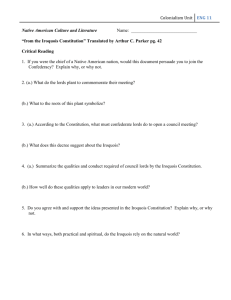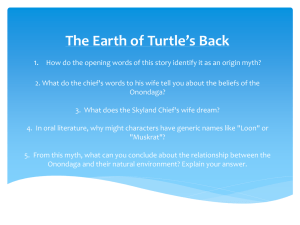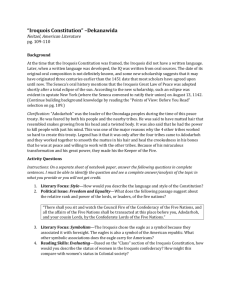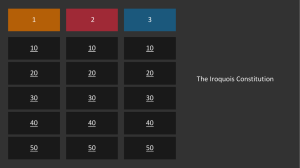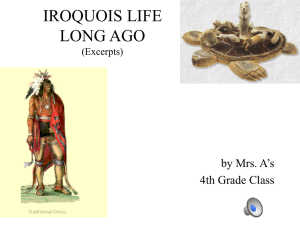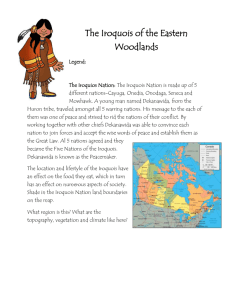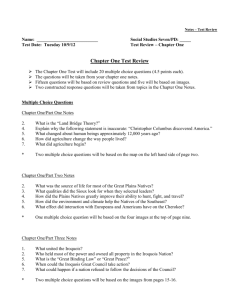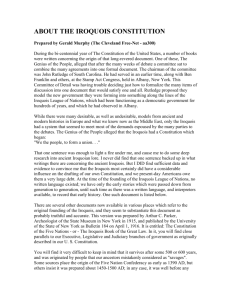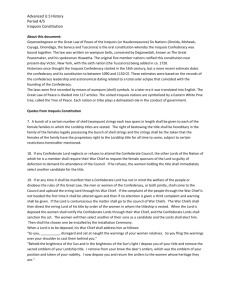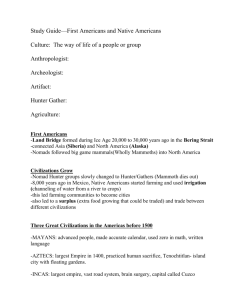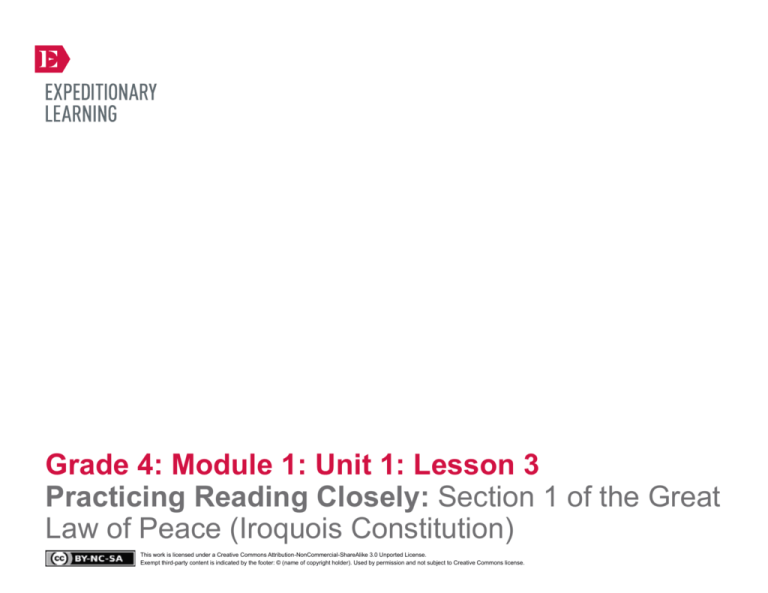
Grade 4: Module 1: Unit 1: Lesson 3
Practicing Reading Closely: Section 1 of the Great
Law of Peace (Iroquois Constitution)
This work is licensed under a Creative Commons Attribution-NonCommercial-ShareAlike 3.0 Unported License.
Exempt third-party content is indicated by the footer: © (name of copyright holder). Used by permission and not subject to Creative Commons license.
GRADE 4: MODULE 1: UNIT 1: LESSON 3
Practicing Reading Closely: Section 1 of the Great Law
of Peace (Iroquois Constitution)
Long-Term Targets Addressed (Based on NYSP12 ELA CCLS)
I can explain what a text says using specific details from the text. (RI.4.1)
I can explain the main points in a historical text accurately. (RI.4.3)
I can engage effectively in a collaborative discussion. (SL.4.1)
Supporting Learning Targets
Ongoing Assessment
• I can use details and examples from the Iroquois Constitution when explaining what specific passages
say or mean.
• Teacher observation
• Students’ annotated text (Section 1 of Great Law of
Peace)
Agenda
Teaching Notes
1.
• Carefully review Helping Students Read Closely (Appendix 1).
Opening
A. Getting Ready to Read the Great Law of
Peace (Iroquois Constitution) (10 minutes)
2. Work Time
A. Introduction to Great Law of Peace
(Iroquois Constitution): Understanding an
Oral Tradition (10 minutes)
B. Modeling and Practicing a Close Read of
Section 1 of the Great Law of Peace
(Iroquois Constitution) (20 minutes)
• Today students begin reading closely some specific sections of the Great Law of Peace. This is a very challenging
document, and students will revisit sections throughout the entire module.
• During Unit 1, students will read Sections 1, 4, 7, and 24 (provided in Supporting Materials at the end of this
lesson).
• In Unit 3 (a month from now), students will revisit these four sections and read some additional sections.
• In this lesson, students only read the Background Information and Section 1. Consider providing just that chunk
of text today.
• Note: Tomorrow (Lesson 4), students will reread the background information and additional portions of the
constitution.
C. Developing a Close Reading Anchor Chart
(10 minutes)
3. Closing and Assessment
A. Debrief (10 minutes)
4. Homework
Copyright © 2013 by Expeditionary Learning, New York, NY. All Rights Reserved.
NYS Common Core ELA Curriculum • G4:M1:U1:L3 • June 2013 •
1
GRADE 4: MODULE 1: UNIT 1: LESSON 3
Practicing Reading Closely: Section 1 of the Great Law
of Peace (Iroquois Constitution)
Lesson Vocabulary
Materials
details, examples, oral tradition,
historical text, reading closely,
confederacy, constitution, Lords
• Sections 1, 4, 7, and 24 from the Great Law of Peace (Iroquois Constitution) (one per student)
• Close Readers Do These Things anchor chart (new; teacher created; see Work Time C)
• Things to Tell Tim anchor chart (begun in Lesson 2)
• Document camera
Opening
Meeting Students’ Needs
A. Getting Ready to Read the Great Law of Peace (Iroquois Constitution) (10 minutes)
• ELLs may be unfamiliar with more
vocabulary words than are
mentioned in this lesson.
• Remind students that in Lessons 1 and 2, they read a little bit about the Iroquois Great Law of Peace.
• Tell them: “Today, in order to become so expert that we can advise Tim, we are going to read sections of the actual Iroquois
Great Law of Peace.”
• Tell students that this document is historical text that was written down many years after the words were first spoken. Long
ago, the Iroquois shared everything orally, which means they just said it out loud and passed the information down to their
children by telling stories. This is called an oral tradition. They had no written language. The words that students will read
today were actually written by a historian who studied the Iroquois.
• Check for comprehension of general
words (e.g., law, peace, etc.) that
most students would know.
• Tell students that it will be exciting to read the words that the people of the Iroquois Nation believe were actually spoken by
the Great Peacemaker.
• Ask if they think his words will sound like fourth-grade words. Why or why not? Emphasize that throughout this year, they
will have many opportunities to read challenging text.
• Share the learning target. Remind students they have practiced this target in previous sessions. Check in on their
understanding of details and examples. Tell them that today they will be reading words that many people believe were
actually spoken by the Great Peacemaker.
Copyright © 2013 by Expeditionary Learning, New York, NY. All Rights Reserved.
NYS Common Core ELA Curriculum • G4:M1:U1:L3 • June 2013 •
2
GRADE 4: MODULE 1: UNIT 1: LESSON 3
Practicing Reading Closely: Section 1 of the Great Law
of Peace (Iroquois Constitution)
Work Time
Meeting Students’ Needs
A. Introduction to the Great Law of Peace (Iroquois Constitution): Understanding an Oral
Tradition (10 minutes)
• Distribute a copy of the Great Law of Peace (Iroquois Constitution) (Sections 1, 4, 7, and 24).
• Reading aloud to students who
cannot access the text
independently helps them reach
the target.
• Read the Overview and Background Information section aloud without much commentary or questioning. This first read is a
scaffold to help students access the text.
• Ask students to reread the background information and overview independently. As they are reading, post the following
questions on the board or with a document camera:
* How many different groups did the Great Peacemaker “join together in peace”?
* What is a “confederacy”?
* In your own words, explain what the last sentence means.
• Read each question aloud. Tell students that today they are just getting oriented, so it is fine if they don’t know all the answers.
They will reread this text in the next lesson.
• Invite students to Think-Pair-Share, encouraging them to go back into the text and find the relevant details and/or the answer.
• Call on students to answer specific questions. Remember that the goal of this early questioning is not to assess whether students
have a full comprehension of the text—they likely do not—but to give them the opportunity to think in a focused way about what
they are reading.
• Support students’ answers by probing them to refer back to the text. For example: “Tell me more about why you think that” and
“Show me in the text where that is or what made you think that.”
• Explain to students the word confederacy consists of “con” + “fed” + “acy.” Con = together, fed = trust, acy = a quality or state of
being. Confederacy = groups that are together based on trust. Explain the morphology of words this way as often as you can.
• For students needing additional
support and ELLs, consider
providing smaller chunks of text,
sometimes just a few sentences
for a close read. Teachers can
check in on students’ thinking as
they speak about their text.
• Encourage students to use word
attack strategies: prefixes, root
words, suffixes, cognates, and
context. Consider partnering an
ELL with a student who speaks
the same L1 when discussion of
complex content is required.
This can allow students to have
more meaningful discussions
and clarify points in their native
language.
• When ELLs are asked to produce
language, consider providing a
sentence frame, sentence starter,
or a cloze sentence to assist with
language production and the
structure required.
Copyright © 2013 by Expeditionary Learning, New York, NY. All Rights Reserved.
NYS Common Core ELA Curriculum • G4:M1:U1:L3 • June 2013 •
3
GRADE 4: MODULE 1: UNIT 1: LESSON 3
Practicing Reading Closely: Section 1 of the Great Law
of Peace (Iroquois Constitution)
Meeting Students’ Needs
Work Time (continued)
B. Modeling and Practicing a Close Read of a Section 1 of the Great Law of Peace (Iroquois Constitution)
(20 minutes)
• Read Section 1 of the Iroquois Constitution aloud as students follow along in the text.
• Ask students for a thumbs-up if they think they can tell something about what they read. Praise the thumbs-up and say: “Tell
your neighbor what you think this is mostly about.”
• Tell students they will now reread Section 1 to see what else they can learn from this passage. Ask the students to “dive in!” and
silently reread Section 1. Tell students not to worry about words they do not know during this first independent read. If you
notice students quickly skimming the text, prompt them to slow down and read carefully and slowly.
• Ask students a big-picture question about Section 1: “Who are the confederate Lords?” Allow students to discuss ideas with a
neighbor. Invite students to share out. Clarify as needed to ensure that students understand that the rulers of the Five Nations
have gathered and are being addressed by Dekanawidah. If needed, clarify the meaning of “Lords” in this context. Help students
notice the significance of the capital letters.
• Model for students the work they will do (with their brains and their pencils) when they are reading closely. Reread Section 1 a
second time, sentence by sentence.
• Beginning with the first sentence, underline things students know already from their learning about The Great Peacemaker
from earlier lessons (Dekanawidah, the Five Nations, the Tree of Peace, Adodarhoh). Tell students you are underlining the
things you already know.
• Then reread a third time, circling unfamiliar words or phrases such as firekeepers and globe thistle. Tell students you are
circling words that seem important, but that you’re not sure why.
• Model for students how readers wonder to themselves about places where they are confused. Show students how you keep
reading or back up and reread to fix your confusion.
• For example, ask: “I’m confused about something. What are ‘firekeepers’?” Model how to return to the text and determine the
meaning from context. “I underlined the word firekeepers. I’m not sure what firekeepers are, but there is a word in there I
know: keepers. I think this might mean that they are in charge of keeping their tribe safe.”
• Then ask your students: “What is a globe thistle?” Listen for student responses such as “a plant,” “something in nature,” or
“something soft.”
Copyright © 2013 by Expeditionary Learning, New York, NY. All Rights Reserved.
NYS Common Core ELA Curriculum • G4:M1:U1:L3 • June 2013 •
4
GRADE 4: MODULE 1: UNIT 1: LESSON 3
Practicing Reading Closely: Section 1 of the Great Law
of Peace (Iroquois Constitution)
Meeting Students’ Needs
Work Time (continued)
• If students need support with this, model briefly: “It does say they are sitting on them. But now I see that it says they are soft.
And since this was long ago when people didn’t have things like couches, I think this must be something from nature. I think
globe thistles might be soft plants.”
• Ask students to turn and talk briefly about what they noticed in the modeling during this second read. Invite a few students to
share out.
• Ask students: “What is this section of the Iroquois Constitution mostly about?” After students have responded (and perhaps you
have clarified), tell students that their early sense of what something is about is called the gist.
• Then model how to state the gist of a section in the words of one of your students, or in your own words if necessary. Write it as
a short phrase in the margin.
• An example might be, “The Iroquois leaders are meeting under the Great Tree of Peace.”
• Say: “Please reread the section again and think about whether our gist statement is accurate.” Ask students to tell you specific
things from the text that they think make the gist statement accurate. As students offer details, be sure they are from the text.
Be sure to reinforce for students how well they are doing making sense of a complex text.
Copyright © 2013 by Expeditionary Learning, New York, NY. All Rights Reserved.
NYS Common Core ELA Curriculum • G4:M1:U1:L3 • June 2013 •
5
GRADE 4: MODULE 1: UNIT 1: LESSON 3
Practicing Reading Closely: Section 1 of the Great Law
of Peace (Iroquois Constitution)
Work Time (continued)
Meeting Students’ Needs
C. Developing a Close Reading Anchor Chart (10 minutes)
• Anchor charts provide a visual
cue to students about what to do
when you ask them to work
independently. They also serve
as note-catchers when the class
is co-constructing ideas.
• Work with students to reflect on the steps they just took to read Section 1 of the Great Law of Peace. Remind them that they
took similar steps when really “The (Really) Great Law of Peace” during Lessons 1 and 2.
• Ask them to discuss with their neighbors and write down the things they did to read closely. Ask students to report out to
develop the Close Readers Do These Things anchor chart. Be sure the following actions are included:
Read small chunks of text slowly and think about the gist.
Reread each passage one sentence at a time.
Underline things that you understand or know about.
Circle or underline words that you do not know.
Talk with your partners about all of your good ideas.
State the gist or message of the paragraph in the margin.
Listen to the questions:
—Go back to the text in order to find answers to questions.
—Talk with your partners about the answers you find.
• Help students understand that these choices are not rigid steps—the basic idea is to read, reread, think, talk, and write.
Copyright © 2013 by Expeditionary Learning, New York, NY. All Rights Reserved.
NYS Common Core ELA Curriculum • G4:M1:U1:L3 • June 2013 •
6
GRADE 4: MODULE 1: UNIT 1: LESSON 3
Practicing Reading Closely: Section 1 of the Great Law
of Peace (Iroquois Constitution)
Closing and Assessment
Meeting Students’ Needs
A. Debrief (5 minutes)
• Ask students what they learned that should go on the Things to Tell Tim anchor chart. (Tim does refer to the Great Law
of Peace in the video, though students may not remember. Remind them if needed.) Add students’ suggestions to the Things
to Tell Tim anchor chart.
• Developing self-assessment and
reflection supports all learners, but
research shows it supports
struggling learners most.
• Debrief the close-reading experience. Ask students to turn and talk to a partner to answer the following question: “What
parts of today’s lesson helped you learn from hard reading?” After they have talked in pairs, share out and celebrate
students’ great reading.
• Tell them that they will continue to practice close reading in the next lesson with other passages from the Great Law of
Peace. Remind them that they will be practicing close reading throughout this year. Encourage them for their initial efforts.
• Provide ELLs with a sentence
starter to aid in language
production. For example: “One rule
from the Great Law of Peace is
_______.”
Homework
Meeting Students’ Needs
• Ask students to read Section 1 of the Great Law of Peace out loud to someone at home, or in front of a mirror.
• Students who cannot yet read
independently at any level will
benefit from hearing books read to
them, either by a caregiver or
through audio recordings. Hearing
books/texts can be an ongoing
assignment for these students.
• Students should continue their independent reading related to this unit.
Copyright © 2013 by Expeditionary Learning, New York, NY. All Rights Reserved.
NYS Common Core ELA Curriculum • G4:M1:U1:L3 • June 2013 •
7
Grade 4: Module 1: Unit 1: Lesson 3
Supporting Materials
This work is licensed under a Creative Commons Attribution-NonCommercial-ShareAlike 3.0 Unported License.
Exempt third-party content is indicated by the footer: © (name of copyright holder). Used by permission and not subject to Creative Commons license.
GRADE 4: MODULE 1: UNIT 1: LESSON 1
The Great Law of Peace (Iroquois Constitution)
Overview and Background Information: Oral Tradition
Dekanawidah (day-kahn-na-WEE-da), the Great Peacemaker, convinced the Seneca, Cayuga, Onondaga, Oneida, and Mohawk
nations to join together in peace. They established a Confederacy. This means that each tribe kept its own land, language, and
culture, but they all agreed to some rules that would help them make decisions and get along peacefully. The set of rules was
called “The Great Law of Peace” and was also known as the Iroquois Constitution. These rules were not written down at first.
Dekanawidah shared these rules out loud at a meeting near present-day Syracuse, NY. He was talking to the leaders of the five
nations. He said the words specifically to Adodarhoh, also known as Tadodahoh, the leader of the Onondaga nation, and other
leaders who were at the meeting. Others who heard Dekanawidah say the rules of peace retold the rules to their own families.
Over the years the rules were told and retold. Someone finally wrote the words down. Because the rules were told out loud for a
long time, it is hard to know if the versions that are written down say exactly what Dekanawidah said.
The Great Law of Peace has more than 100 rules that are about everything from making decisions to adopting children to what to
say at a funeral. Below are just a few sections of one version of the Great Law of Peace, Prepared by Gerald Murphy (The
Cleveland Free-Net - aa300). Distributed by the Cybercasting Services Division of the National Public Telecomputing Network
(NPTN).1
Section 1 of the Great Law of Peace
1. I am Dekanawidah and with the Five Nations’ Confederate Lords I plant the Tree of Great Peace.
I plant it in your territory, Adodarhoh and the Onondaga Nation, in the territory of you who are Firekeepers.
I name the tree the Tree of the Great Long Leaves. Under the shade of this Tree of the Great Peace we spread the soft white
feathery down of the globe thistle as seats for you, Adodarhoh, and your cousin Lords.
We place you upon those seats, spread soft with the feathery down of the globe thistle, there beneath the shade of the spreading
branches of the Tree of Peace. There shall you sit and watch the Council Fire of the Confederacy of the Five Nations, and all the
affairs of the Five Nations shall be transacted at this place before you, Adodarhoh, and your cousin Lords, by the Confederate
Lords of the Five Nations.
Copyright © 2013 by Expeditionary Learning, New York, NY. All Rights
Reserved.
NYS Common Core ELA Curriculum • G4:M1:U1:L2 • June 2013 •
9
GRADE 4: MODULE 1: UNIT 1: LESSON 1
The Great Law of Peace (Iroquois Constitution)
Section 4 of the Great Law of Peace
4. You, Adodarhoh, and your thirteen cousin Lords shall faithfully keep the space about the Council Fire clean and you shall
allow neither dust nor dirt to accumulate. I lay a Long Wing before you as a broom. As a weapon against a crawling creature I
lay a staff with you so that you may thrust it away from the Council Fire. If you fail to cast it out then call the rest of the
United Lords to your aid.
Section 7 of the Great Law of Peace
7. Whenever the Confederate Lords shall assemble for the purpose of holding a council, the Onondaga Lords shall open it by
expressing their gratitude to their cousin Lords and greeting them, and they shall make an address and offer thanks to the
earth where men dwell, to the streams of water, the pools, the springs and the lakes, to the maize and the fruits, to the
medicinal herbs and trees, to the forest trees for their usefulness, to the animals that serve as food and give their pelts for
clothing, to the great winds and the lesser winds, to the Thunderers, to the Sun, the mighty warrior, to the moon, to the
messengers of the Creator who reveal his wishes, and to the Great Creator who dwells in the heavens above, who gives all the
things useful to men, and who is the source and the ruler of health and life. Then shall the Onondaga Lords declare the
council open.
Section 24 of the Great Law of Peace
24. The Lords of the Confederacy of the Five Nations shall be mentors of the people for all time. The thickness of their skin
shall be seven spans—which is to say that they shall be proof against anger, offensive actions and criticism. Their hearts
shall be full of peace and goodwill, and their minds filled with a yearning for the welfare of the people of the Confederacy.
With endless patience they shall carry out their duty, and their firmness shall be tempered with a tenderness for their
people. Neither anger nor fury shall find lodgment in their minds, and all their words and actions shall be marked by calm
deliberation.
Overview and Background Information written by Expeditionary Learning for instructional purposes. Excerpt from “The Great Law of Peace” reprinted with
permission. Prepared by Gerald Murphy and distributed by the National Public Telecomputing Network (NPTN).
Copyright © 2013 by Expeditionary Learning, New York, NY. All Rights
Reserved.
NYS Common Core ELA Curriculum • G4:M1:U1:L2 • June 2013 •
10

